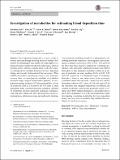Investigation of metabolites for estimating blood deposition time
Abstract
Trace deposition timing reflects a novel concept in forensic molecular biology involving the use of rhythmic biomarkers for estimating the time within a 24-h day/night cycle a human biological sample was left at the crime scene, which in principle allows verifying a sample donor’s alibi. Previously, we introduced two circadian hormones for trace deposition timing and recently demonstrated that messenger RNA (mRNA) biomarkers significantly improve time prediction accuracy. Here, we investigate the suitability of metabolites measured using a targeted metabolomics approach, for trace deposition timing. Analysis of 171 plasma metabolites collected around the clock at 2-h intervals for 36 h from 12 male participants under controlled laboratory conditions identified 56 metabolites showing statistically significant oscillations, with peak times falling into three day/night time categories: morning/noon, afternoon/evening and night/early morning. Time prediction modelling identified 10 independently contributing metabolite biomarkers, which together achieved prediction accuracies expressed as AUC of 0.81, 0.86 and 0.90 for these three time categories respectively. Combining metabolites with previously established hormone and mRNA biomarkers in time prediction modelling resulted in an improved prediction accuracy reaching AUCs of 0.85, 0.89 and 0.96 respectively. The additional impact of metabolite biomarkers, however, was rather minor as the previously established model with melatonin, cortisol and three mRNA biomarkers achieved AUC values of 0.88, 0.88 and 0.95 for the same three time categories respectively. Nevertheless, the selected metabolites could become practically useful in scenarios where RNA marker information is unavailable such as due to RNA degradation. This is the first metabolomics study investigating circulating metabolites for trace deposition timing, and more work is needed to fully establish their usefulness for this forensic purpose.
Citation
Lech , K , Liu , F , Davies , S K , Ackermann , K , Ang , J E , Middleton , B , Revell , V L , Raynaud , F J , Hoveijn , I , Hut , R A , Skene , D J & Kayser , M 2018 , ' Investigation of metabolites for estimating blood deposition time ' , International journal of legal medicine , vol. 132 , no. 1 , pp. 25-32 . https://doi.org/10.1007/s00414-017-1638-y
Publication
International journal of legal medicine
Status
Peer reviewed
ISSN
0937-9827Type
Journal article
Description
This study was supported by a UK Biotechnology and Biological Sciences Research Council (BBSRC) Grant (BB/I019405/1) to DJS, grant 727.011.001 from the Netherlands Organization for Scientific Research (NWO) Forensic Science Program to MK and by Erasmus MC University Medical Centre Rotterdam. DJS is a Royal Society Wolfson Research Merit Award holder. RAH and IH were funded by the Dutch applied research foundation (STW Perspectief Program ‘OnTime’ project 12185).Collections
Items in the St Andrews Research Repository are protected by copyright, with all rights reserved, unless otherwise indicated.

